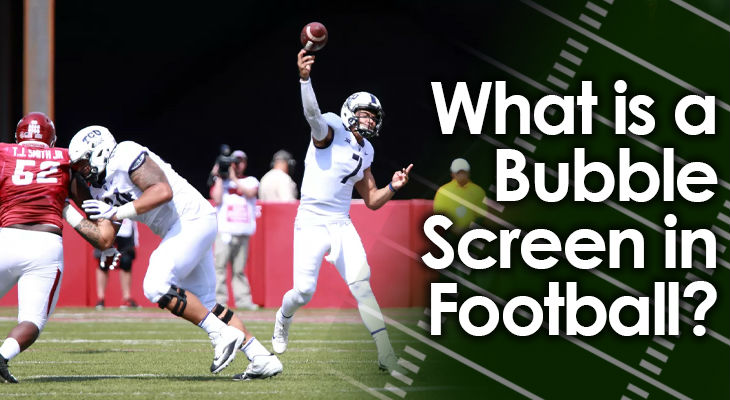Screens are a type of pass that is thrown in football to keep defenses off-balance, but different types of screens do so in different ways.
Traditional screen passes are designed to make the defense think the play is designed for a long pass, but then dump the ball off to an underneath receiver.
In these screen passes, the running back is often the target of the short pass, which is designed to eliminate defensive linemen by allowing them to get in the backfield, freeing the offensive linemen up to block downfield.
A bubble screen, though, works in the opposite way...
It is a pass play that is designed to get the ball out of quarterback’s hands and into the receiver’s hands as quick as possible.
The work, then, is on the receivers to do the initial blocking, and for the player catching the ball to make a move or two to get downfield.
Let’s have a closer look at the bubble screen so we can know exactly what it is, how it’s run, and when it’s best used.
What is a Bubble Screen?
A bubble screen is a pass that gets the ball out of the quarterback’s hands quickly.
It’s meant to spread the ball out wide to a wide receiver or tight end, and get it into his hands as quickly as possible so he can gain yardage after making the catch.
Unlike a traditional screen pass, the design of a bubble screen is to spread the defense out and take advantage of matching up blockers to outside linebackers, cornerbacks, and safeties.
These will be the initial points of blocking contact, instead of over the middle of the field.
The idea of a bubble screen is to take advantage of your receiver’s speed and elusiveness with a play that is executed quickly toward the outside of the field.
If it works as designed, it can result in big yardage gains toward one of the sidelines.
How Does a Bubble Screen Work?
A bubble screen is most often run out of a formation that has multiple receivers spread out wide.
It isn’t run with a tight formation or one in which multiple tight ends and running backs are stacked close to the line of scrimmage. That would ultimately defeat the purpose of the play and make the bubble screen very hard to execute.
Teams can run a bubble screen with the quarterback either under center or out of the shotgun.
Most of the time, there will be one running back in the backfield and either one or no tight end lined up tight at the line of scrimmage.
With no tight end next to one of the offensive tackles, there will be three wide receivers with one tight end spread out wide (or four wide receivers and no tight end).
Two of these receivers will line up on the line of scrimmage, while the other two will line up off the line of scrimmage.
Most of the time, three of these receivers will be on the side of the field where the pass is going, while the fourth will line up on the other side.
One of these receivers will be the player who is going to catch the pass, while the other three will serve as primary blockers.
At the snap, the primary target will take a curved path toward the sideline on his side of the ball.
The quarterback will immediately turn toward that primary target and throw him the ball right away.
The job of the other receivers — especially on the same side of the field as the primary target — is to block the players lined up opposite them to the inside of the field.
This will force the defender responsible for the primary target to make his way behind the two other defenders to try to make the tackle on the receiver with the ball.
The ball carrier’s job is to make a move and get as much yardage downfield as possible by running up the outside of the field toward the sideline.
In a bubble screen, the offensive linemen’s job is to try to push the defenders lined up opposite them away from where the ball carrier is, and then shed those defenders to get upfield to help block at the second level.
The Best Time to Use a Bubble Screen
As we all know, not every play in football is a great fit for every situation.
So, when is the bubble screen a good fit, and when is it not?
The great part about bubble screens are that they can be run successfully in both short and long-yardage situations.
If you’re facing a short distance to get a first down, and you have confidence in your receivers’ ability to make a move with the football, then a bubble screen is a great way to get those few yards quickly to get a new set of downs.
At the same time, teams will often use a bubble screen when they are facing a third-and-long situation.
That’s because the bubble screen is a relatively low-risk play that will keep the ball in your team’s hands with the potential for a big yardage gain.
In this regard, some teams prefer to run a bubble screen on a third-and-long situation rather than a draw running play, as at least there is a decent shot to gain enough yardage to make a first down.
It isn’t just a throw-away play on third and long.
With the proper personnel, proper alignment, and proper timing, the bubble screen can be a great addition to any football team’s offensive playbook.
It keeps defenses off balance and takes advantage of speedy and powerful receivers’ skillsets while targeting the position that is often made up of the weakest tacklers on defense.

